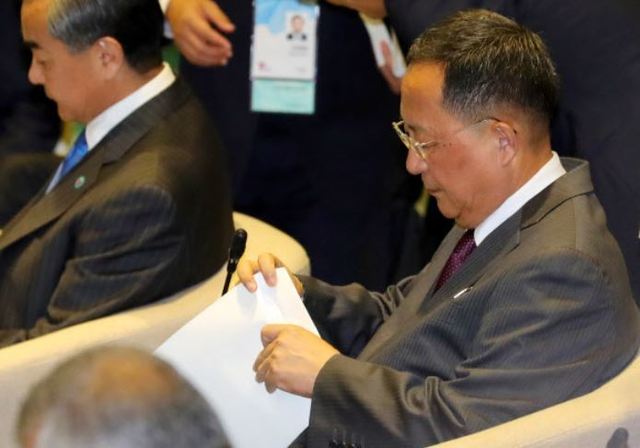Posted on : Aug.6,2018 17:21 KST
Modified on : Aug.6,2018 17:35 KST
 |
|
North Korean Foreign Minister Ri Yong-ho opens an envelope he received from US Ambassador to the Philippines Sung Kim. (Yonhap News)
|
The foreign ministers’ meeting at the ASEAN Regional Forum ended without a breakthrough in denuclearization negotiations between North Korea and the US. Though the two countries’ top diplomats exchanged warm greetings and pleasantries, promising to meet again soon, there was a clear divide in their opinions, and the battle of nerves continued. At this rate, one can’t rule out the possibility of the deadlock in the negotiations becoming protracted. There’s a greater need to move beyond the usual approach to negotiations and find a new kind of leader-driven solution.
While US Secretary of State Mike Pompeo said while attending the meeting that he was certain of North Korean leader Kim Jong-un’s commitment to denuclearization, he reiterated the importance of sanctions on the North. He also urged the international community to implement those sanctions.
North Korean Foreign Minister Ri Yong-ho emphasized the North’s standard position that the implementation of the two countries’ joint agreement must be “phased and synchronous” and criticized the US for going back on the issue of declaring the end of the war, which the North regards as an initial step toward guaranteeing peace on the Korean Peninsula.
The two sides seem unable to bridge that divide, with one insisting on steps toward denuclearization and the other stressing a phased and synchronous implementation that includes an end-of-the-war declaration. And there are also concerns that this delicate situation could get worse, with the US Department of the Treasury pushing through additional sanctions of its own against the North and the UN going public with cases of North Korea violating UN sanctions.
The prolongation of the deadlock between North Korea and the US is not helping anyone. In order to create a breakthrough in the negotiations, the leaders of North Korea and the US need to make more aggressive use of the “top-down” method to bring dramatic change to the situation.
It’s significant that US President Donald Trump’s response to a personal letter from Kim was handed to the North Koreans at an international conference that was being watched by people from many countries. It’s clear that this kind of “letter diplomacy” is helping to preserve the momentum of dialogue even while the negotiations themselves are going nowhere fast.
But by itself, that’s not enough. One of the reasons the American government continues to use pressure tactics against North Korea is because of mainstream American society’s distrust of North Korea. The top-down method is effective at assuaging that skepticism toward the talks. Since Kim and Trump exchanged telephone numbers during their meeting in Singapore, if necessary they could also consider discussing key issues over the phone.
It’s also important for the South Korean government to play the role of a facilitator in North Korea-US relations. Even while seeking to persuade the US to make a bold decision about the end-of-the-war declaration and North Korea to agree to the US’s demand to submit a list of nuclear facilities, Seoul needs to proactively offer an alternative that will be palatable to both North Korea and the US.
Please direct comments or questions to [english@hani.co.kr]






